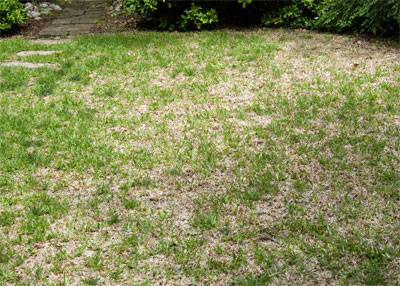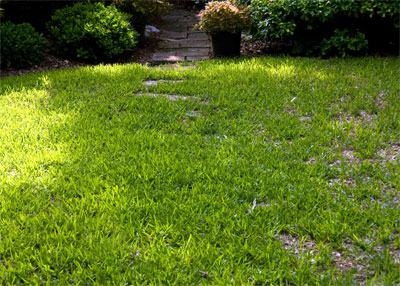From the Sperry Garden – May, 2010
Lawns all across Texas were slow to green up following this past unusual winter and early spring. St. Augustine was especially troubled, so when we returned from a week out of town to find a lawn that looked as bad as it had before, I decided it was time to give it the sphagnum peat moss treatment for Take All Root Rot.
Before I applied the peat moss, I checked with my two go-to turf and TARR experts, Dr. James McAfee and Dr. Phil Colbaugh. Jim and I have known each other for all of our lives. He continues his great turf work with TAMU, and Phil, now retired, is a fine plant pathologist, formerly with the Texas Agricultural Experiment Station.
Both men confirmed that much of the damage this spring was due to TARR. Jim told me that he has heard of damage to St. Augustine as far south as the northern suburbs of Houston. So, while snow and cold damage alone may have been partly responsible, TARR became chief suspect.

Before treatment
I applied 1 inch of Canadian sphagnum peat moss to the large affected area of my Raleigh St. Augustine on May 13. This photo was taken Monday, May 24 – just 11 days later! No fungicide was applied. Dr. Colbaugh has told me through the years that fungicides just don’t work very well on this organism.

After treatment
This is an even more dramatic turnaround from TARR damage than I saw several years ago when I posted the photos that we’ve had in the MAQ section of my website. Really proves the benefit of creating that acidic interface at the soil line. This organism greatly favors alkaline conditions.
We are also seeing reports that bermudagrass lawns are also being damaged by TARR. If these symptoms apply to your bermuda turf, it might be worth considering.
Again, public thanks to Texas A&M and its great research programs. We gardeners are the beneficiaries this time. Many others reap similar rewards at other times.

